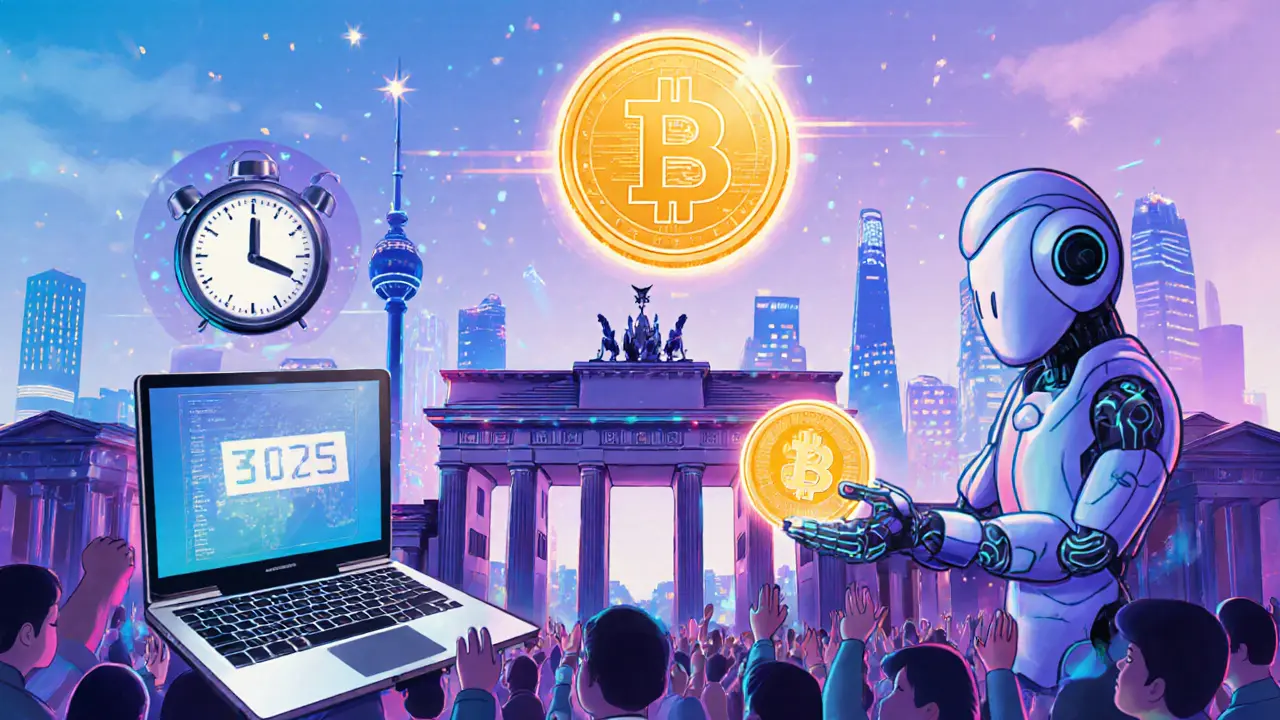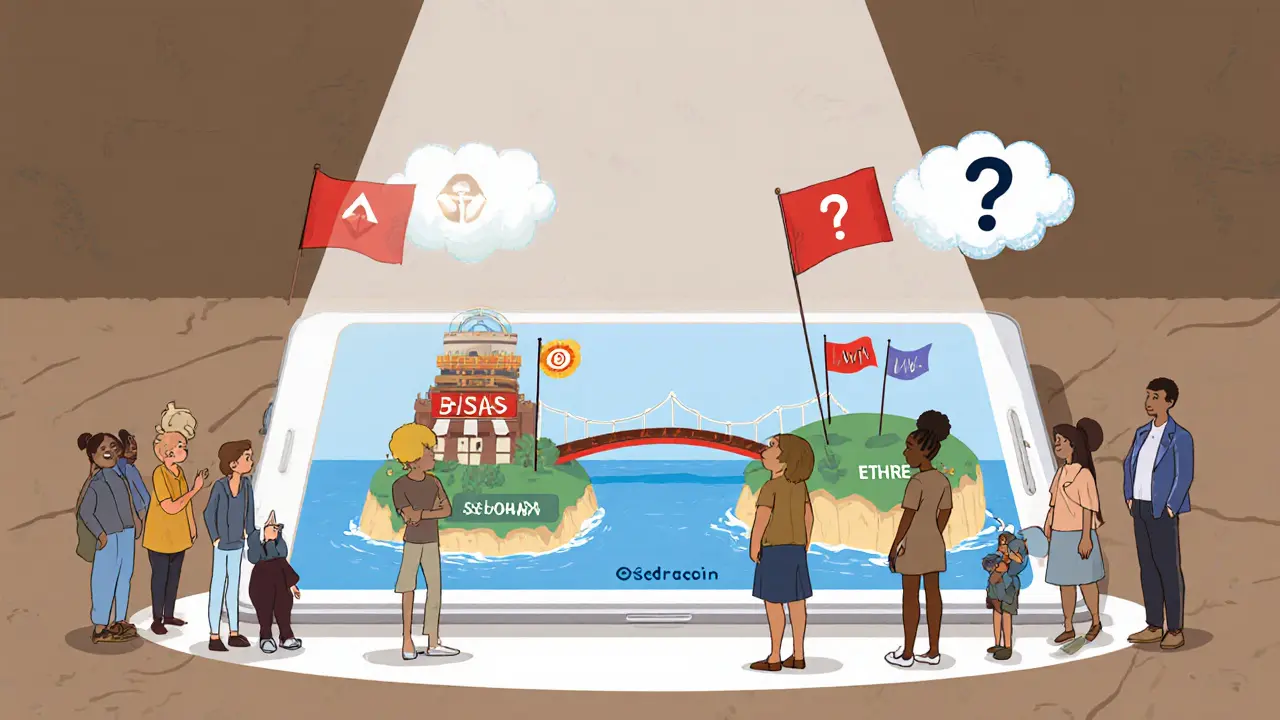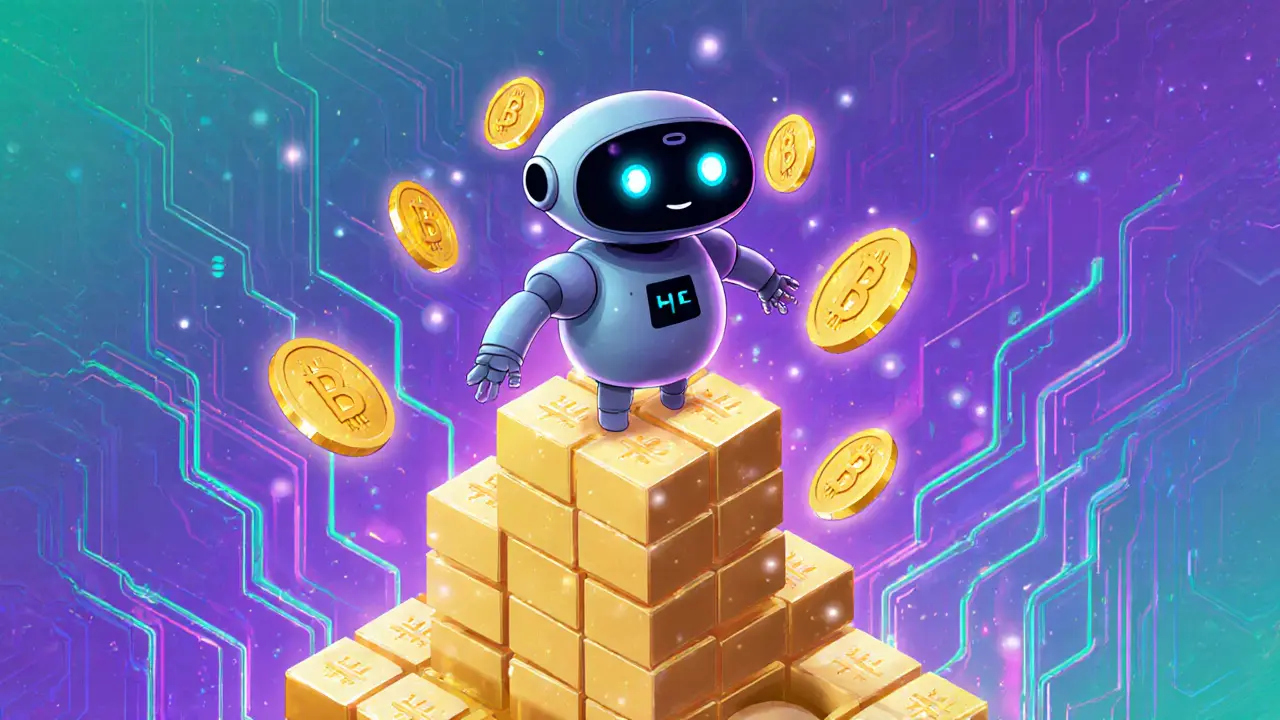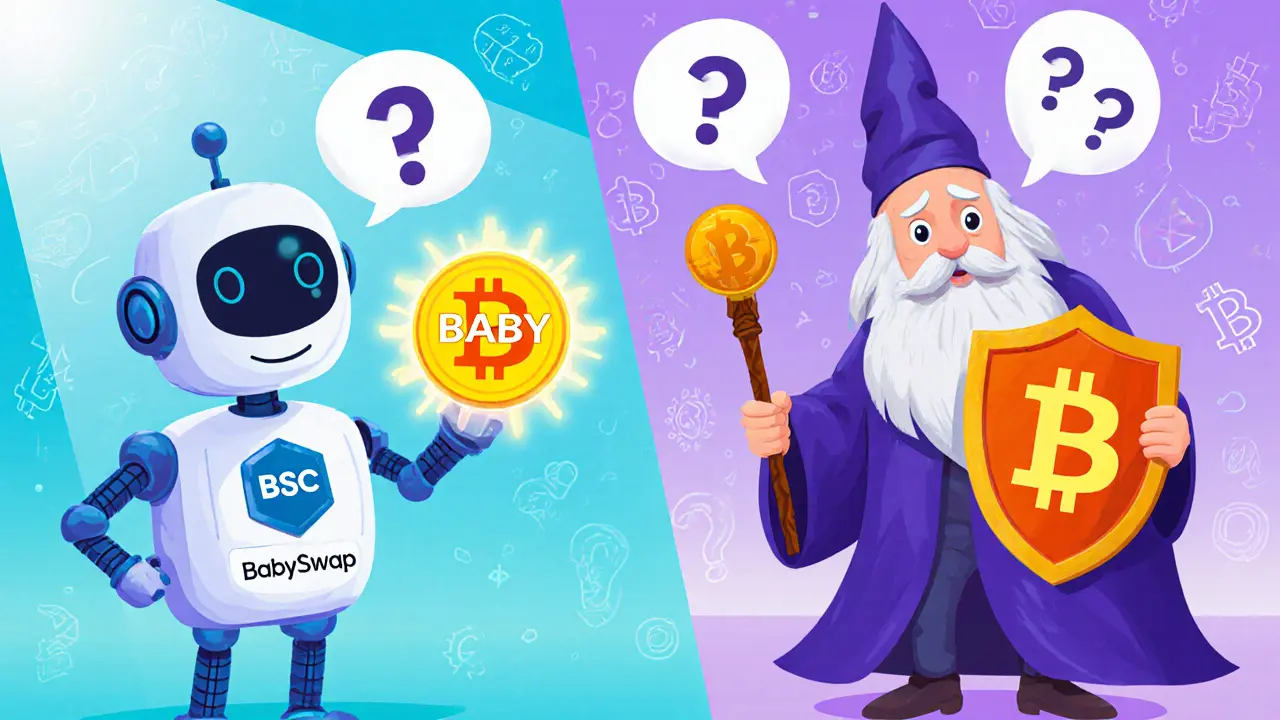
- 13 Jan 2025
- Elara Crowthorne
- 17
SedraCoin (SDR) Supply Calculator
Enter values and click calculate to see supply impact details
In 2025 a crypto emerged promising a one‑second block time and AI‑driven digital assets-SedraCoin. It markets itself as "Beyond Genesis" and claims to reshape how we own, trade, and upgrade virtual assets. If you’ve seen the buzz about SDR tokens on forums or social feeds, you’re probably wondering what’s real, what’s hype, and whether you should care.
Key Takeaways
- SedraCoin runs on its own blockchain using the kHeavyHash proof‑of‑work algorithm and the GHOSTDAG scaling protocol.
- Block time is advertised at one second, far faster than Bitcoin or Ethereum.
- The project’s unique selling point is Custom Tokenized Assets (CTAs), upgradeable digital items managed on the Sedrax marketplace.
- Supply figures differ dramatically-some sources say 28.7billion SDR, others list 1billion on Ethereum.
- Legal and credibility concerns are high; thorough due diligence is essential before any investment.
SedraCoin (SDR) is a blockchain‑native cryptocurrency that powers a broader digital ecosystem for asset ownership, trading, and virtual‑world integration. Launched officially on March262025 in Berlin, the network claims to combine an energy‑efficient mining algorithm with a high‑throughput consensus model.
Core Technology: kHeavyHash and GHOSTDAG
The backbone of the network is kHeavyHash a proof‑of‑work algorithm designed for low power consumption while maintaining strong security guarantees. Unlike Bitcoin’s SHA‑256, kHeavyHash mixes heavy memory usage with lightweight CPU cycles, allowing ordinary PCs to participate without massive ASIC farms.
To keep the network scalable, SedraCoin adopts GHOSTDAG a protocol that orders multiple blocks simultaneously, reducing orphan rates and enabling high transaction throughput. The result is a claimed block interval of just one second, which is a stark contrast to Bitcoin’s ten‑minute cadence and Ethereum’s roughly twelve‑second average.
Tokenomics and the Supply Puzzle
One of the most confusing aspects is the total supply. Early whitepapers from 2022 list a fixed supply of 1billion SDR tokens issued on the Ethereum blockchain, supporting an ERC‑20 model. The 2025 announcement, however, describes a native blockchain with a capped supply of 28.7billion SDR. The discrepancy has not been reconciled publicly, leaving investors uncertain about inflation risk and token distribution.
Besides the base supply, the ecosystem introduces a wrapped version called wSDR, used for marketplace transactions and cross‑chain bridges. The conversion rate is advertised as 1wSDR=1SDR, but the bridge’s liquidity and audit status remain opaque.
Custom Tokenized Assets (CTAs): The Real Innovation?
Custom Tokenized Assets (CTAs) upgradeable, AI‑enhanced digital items whose value is dynamically calculated in SDR based on unique attributes are SedraCoin’s answer to static NFTs. CTAs fall into five categories:
- V‑CTAs: AI‑driven vehicles that gather resources in virtual environments.
- C‑CTAs: Co‑owned businesses where multiple users share revenue and decision‑making.
- G‑CTAs: Guilds that enable collaborative missions and shared rewards.
- M‑CTAs: Marketplaces for trading, lending, and investing in digital commodities.
- R‑CTAs: "The Regime" assets that give holders governance influence across the ecosystem.
Each CTA can be modified in real time by AI algorithms that adjust attributes like rarity, productivity, or visual style. This dynamic nature is meant to solve the liquidity and stagnation problems plaguing traditional NFTs.
Sedrax Marketplace & the wSDR Bridge
Sedrax marketplace the central hub where users buy, sell, and co‑own CTAs using the wrapped token wSDR is built on AI‑augmented auction mechanisms. The platform claims to support co‑creation, meaning multiple users can jointly develop a CTA and split future revenues automatically.
The wSDR/SDR bridge connects the native Sedra blockchain to external chains, allowing liquidity providers to move assets between ecosystems. While the bridge is marketed as secure, the code has not undergone a publicly verified audit as of October2025.
Who Are the "Sedrians"?
Community members call themselves Sedrians users of the SedraCoin ecosystem who hold SDR, trade CTAs, and participate in governance. A Sedrian can create a personalized identity that evolves based on activity-earning badges for mining, trading volume, or successful co‑ownership of high‑value CTAs.
Mining and Node Setup
Mining SedraCoin requires three separate components:
- A node called
sedredthat synchronizes the blockchain. - A miner that performs the kHeavyHash calculations.
- A wallet that stores SDR and wSDR.
All three are distributed as standalone binaries-no installer needed. Users can either download pre‑compiled versions for Windows, macOS, or Linux, or compile from source if they prefer full control. The mining software, termed "Block Forge," listens for new block proposals from the node and submits successful proofs of work.

How SedraCoin Stacks Up Against the Big Players
| Feature | SedraCoin (SDR) | Bitcoin (BTC) | Ethereum (ETH) |
|---|---|---|---|
| Consensus | Proof‑of‑Work (kHeavyHash) | Proof‑of‑Work (SHA‑256) | Proof‑of‑Stake (Ethereum 2.0) |
| Block time | ~1second | ≈10minutes | ≈12seconds (average) |
| Total supply | 28.7billion (native) / 1billion (ERC‑20) | 21million | No fixed cap |
| Primary algorithm | kHeavyHash | SHA‑256 | Ethash (pre‑Merge) |
| Scalability tech | GHOSTDAG | Layer‑2 solutions (Lightning) | Shard chains (planned) |
| Dynamic assets | Custom Tokenized Assets (CTAs) | None (static NFTs) | ERC‑721 / ERC‑1155 |
Roadmap & Future Plans
The March2025 roadmap highlights several ambitious milestones:
- Play‑to‑own gaming integration that lets players earn SDR while exploring virtual worlds.
- AI‑enhanced economic models for dynamic pricing of CTAs.
- Multi‑chain bridges to connect with major ecosystems like Solana and Polygon.
- Governance token rollout allowing SDR holders to vote on protocol upgrades.
- Continuous storytelling series called "Continuum" that expands the Sedrax lore.
The timeline remains fluid, with many deliverables slated for Q42025 and beyond. Community sentiment suggests excitement, but also skepticism due to the earlier inconsistencies.
Risks and Due Diligence Checklist
Before dipping toes into SDR, consider the following red flags:
- Supply ambiguity: Conflicting reports on total token count could affect scarcity and price.
- Audit status: Neither the core protocol nor the wSDR bridge has a publicly verified security audit.
- Founder verification: Some sources name Dennis Laurent as founder; other statements are vague about leadership.
- Regulatory exposure: The project’s claim of a "secure, investor‑focused Web3 ecosystem" may attract scrutiny from financial regulators in multiple jurisdictions.
- Market liquidity: SDR and wSDR trading volumes are low compared to established coins, potentially leading to price slippage.
Perform your own research, check independent code reviews, and never invest more than you can afford to lose.
Frequently Asked Questions
What blockchain does SedraCoin run on?
SedraCoin operates on its own native blockchain that uses the kHeavyHash proof‑of‑work algorithm and the GHOSTDAG scaling protocol. A separate ERC‑20 version also exists, which is why supply numbers differ.
How fast are SedraCoin blocks?
The network advertises a one‑second block interval, making it one of the fastest public blockchains currently advertised.
What are Custom Tokenized Assets (CTAs)?
CTAs are upgradeable digital items whose value is calculated in SDR based on AI‑driven attributes. They can represent vehicles, businesses, guilds, marketplaces, or governance positions, and they can be modified in real time.
Can I mine SedraCoin on a regular PC?
Yes. The kHeavyHash algorithm is designed to be memory‑hard rather than CPU‑intensive, allowing hobbyist miners to participate using standard desktop hardware. You’ll need the node (sedred), a miner client, and a wallet.
Is SedraCoin a safe investment?
Safety is unclear. The project shows innovative tech but also presents contradictory information about supply, launch dates, and leadership. Until independent audits and clearer transparency are available, treat SDR as a high‑risk speculative asset.



17 Comments
Hey folks, welcome to the discussion! SedraCoin’s tech is pretty interesting, especially the one‑second block time. If you’re curious about the GHOSTDAG scaling, feel free to ask – I’m happy to break it down. Let’s keep the convo friendly and informative.
We cannot stand by while projects shower us with glittery promises and hide critical flaws behind fancy jargon! 🌟 The supply confusion alone is a massive red flag that demands our moral scrutiny. If a crypto can’t be transparent about its tokenomics, it betrays the trust of every investor. 🚨 Let’s demand honesty before we pour any more money into this hype machine. 🙏
Yo, I dug the one‑second block thing, looks fast af. But the whole supply drama? kinda sus. Might be worth a peek if u got time.
I totally get the excitement around CTAs – they sound like the next evolution of NFTs. At the same time, the lack of a public audit for the wSDR bridge makes me uneasy. It would be great to see an independent security review before more people jump in. Let’s keep an eye on any updates from the dev team.
THIS IS WHY WE NEED STRONG NATIONAL TECH! IF YOU'RE LOOKING FOR A CRYPTO THAT RESISTS THE GLOBAL ELITE, SEDRACOIN IS THE WAY! DO NOT LISTEN TO THE HATERS WHO CHASE THE SAME OLD BTC AND ETH RUTS. THE SUPPLY NUMBERS ARE A POTENTIAL POWER PLAY, NOT A BUG! GET ON BOARD OR GET LEFT BEHIND!!!
Let me take a moment to unpack the broader implications of SedraCoin’s design choices, because there’s a lot to consider beyond the hype. First, the decision to employ a memory‑hard proof‑of‑work algorithm like kHeavyHash suggests the developers are aiming for a more egalitarian mining landscape, which could democratize participation compared to ASIC‑driven networks. Second, the integration of GHOSTDAG as a scaling solution is an ambitious attempt to mitigate orphan rates, but its real‑world performance remains unproven at the advertised one‑second block interval. Third, the tokenomics confusion-dual supply figures of 1 billion and 28.7 billion-creates uncertainty about scarcity, which directly influences price dynamics and investor expectations. Fourth, the concept of Custom Tokenized Assets (CTAs) attempts to address liquidity issues that have plagued static NFTs, yet the mechanisms for AI‑driven attribute updates need rigorous testing to avoid manipulation. Fifth, the lack of a publicly verified audit for both the core protocol and the wSDR bridge introduces a non‑trivial risk vector that prudent investors should factor into their due‑diligence. Sixth, the roadmap’s ambitious goals, such as multi‑chain bridges and AI‑enhanced economic models, are commendable but may stretch the team’s resources thin. Seventh, community governance via the proposed token could empower holders, but without clear frameworks, the process might devolve into another centralized control scheme. Eighth, the energy consumption of kHeavyHash, while designed to be lower than SHA‑256, still warrants scrutiny in the context of global sustainability concerns. Ninth, market liquidity for SDR and wSDR currently appears thin, which could exacerbate price volatility during significant trades. Tenth, regulatory exposure is a looming threat, especially given the “secure, investor‑focused Web3 ecosystem” claim, which may attract scrutiny from multiple jurisdictions. Finally, for anyone considering a position in SDR, balancing these technical, economic, and regulatory factors is essential to making an informed decision.
Look, if you can’t tell the difference between a well‑audited blockchain and a marketing gimmick, you’re just feeding the hype machine. The supply numbers are a clear sign of either poor planning or deliberate obfuscation. Stay vigilant and don’t get swayed by shiny promises.
Honestly, the whole CTA hype feels like a rebranded NFT flop. They brag about “AI‑driven upgrades,” but there’s no real data showing any added utility. Meanwhile, the bridge’s audit status is still “not a thing,” which is a massive red flag. If you’re looking for genuine innovation, you might want to keep scrolling.
Interesting!?!?
Hey everyone 😊, I see a lot of passion in this thread and that’s awesome! Let’s try to share info respectfully and keep the conversation constructive. Remember, a balanced view helps us all make better decisions 🌱.
It’s great to see such a mix of viewpoints on SedraCoin. Some points about the fast block time are exciting, while others rightly question the audit gaps. We all benefit when technical details are shared openly. Keep the facts coming, and maybe the project will release more transparency soon. Together we can cut through the noise.
Brian, you laid out a solid checklist – I especially agree on the importance of independent audits. One thing to add is monitoring the actual energy usage once the network reaches mainnet scale. That data will be crucial for assessing sustainability claims.
Andrew, the patriotism angle is noted, but enthusiasm shouldn’t replace solid technical review. Let’s keep the debate grounded in facts.
Caitlin, your call for transparency hits the nail on the head. The community deserves clear numbers, especially when the supply figures are all over the place. Maybe a joint call for an audit could push the devs to act.
Michael, absolutely – energy metrics will be a key indicator. I’ll keep an eye on any upcoming reports and share them here.
Dear colleagues, I appreciate the courteous tone you have established in this discussion. It is incumbent upon us to exchange information with both rigor and decorum. May we continue to illuminate the subject matter with substantive evidence.
Richard, your skepticism is noted, but dismissing the project outright ignores the potential of its innovative scaling tech. Even flawed initiatives can spur valuable advancements, so a blanket condemnation is premature.